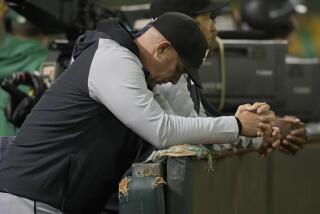The Hawk Has Been Pecking Away at White Sox Personnel
- Share via
CHICAGO — The story of how Ken Harrelson became (The Hawk) begins with a youngster getting hit in the face with a baseball bat. By the time his nose healed, it looked like a beak.
But people who didn’t know much about Hawk before he became the Chicago White Sox vice president for baseball operations last October might suspect other origins. That’s because of the way Harrelson swooped through the White Sox’s front office, picking off personnel.
The first victim was General Manager Roland Hemond, who was quietly shunted to the background before resigning and going to work in the commissioner’s office.
Four weeks ago, Harrelson had fired his own assistant, Dave Dombrowski, and one week later, Manager Tony LaRussa and pitching coach Dave Duncan were dismissed.
Hawk had moved from the White Sox’ broadcasting booth to the front office only several months earlier. He was never indecisive during his playing days or as a broadcaster, and he didn’t change as an executive.
“Philosophical differences,” Harrelson said of the personnel changes. “They found it difficult to adapt to what I wanted to do.”
Don Drysdale, a Hall of Fame pitcher who was Harrelson’s broadcasting partner with the White Sox, saw nothing wrong with Harrelson’s methods.
“He’s not mean, but he is a competitor,” Drysdale said. “That’s good. I like to be around people where you know where you stand. The others are a dime a dozen.
“He knows the game, he has a refreshing mind. Then, there is an aura about him. He’s ‘Hawk’ and he’ll do fine as soon as he gets everything set the way he wants.”
Like the bird whose name he bears, Harrelson sets great store by his plumage. He wears cowboy hats with feathers, pastel-colored shirts and slacks embroidered with the name “Hawk,” and lizard-skinned boots ranging in colors from black to Easter-egg blue.
Another thing Harrelson has is a master plan--though most of his critics find that hard to believe.
Harrelson wants to build an organization “that will be the toughest in the American League. I want to get this club to the point where everyone hates to play us.”
He started by placing former major leaguers in positions of authority. Tom Haller, a former catcher and general manager of the San Francisco Giants, came aboard as general manager. Alvin Dark, a former shortstop and manager, was brought in to run the White Sox farm system.
When Harrelson left broadcasting and took a $100,000 pay cut to become chief of operations, he could have fired everyone and started from scratch.
“That’s what I should have done,” he said, recalling the criticism that resulted from the near-firing of LaRussa almost a month before he actually lost the job. “But I thought we could work it out.
“I like Tony and he’s a good manager. But he was used to doing things a certain way and wanted to keep on doing them that way. It didn’t work out.”
Whether baseball people agree or disagree with his methods, Harrelson certainly has caught everyone’s attention, including White Sox co-owners Jerry Reinsdorf and Eddie Einhorn.
“Hawk is running the baseball operation and he can do what he wants as long as I don’t consider it totally irrational,” said Reinsdorf, who backed that statement by hiring Harrelson’s managerial pick, Jim Fregosi, without an interview.
“Any guy who has a nice, cushy job making a lot of money and takes a cut in pay and puts his neck on the line for what he believes gets my attention,” Einhorn said.
Harrelson, 44, was a star in football, baseball and basketball at Benedictine Military Academy in Savannah, Ga.
He turned down a football scholarship at the University of Georgia to sign with the Kansas City A’s. He reached the major leagues in 1963, several years before owner Charlie O. Finley’s team became the game’s most successful team after he moved it to Oakland.
In those days, the A’s had promotions, but not much else to sell the team, and Harrelson became what he refers to as “Charlie’s Bobo, so to speak.”
Part of that act included riding the team mascot, a mule named Charlie O.
Some considered it demeaning, but not Harrelson.
“I rode the mule for two reasons,” Harrelson said. “It was fun and Finley usually would come up with a new hat or a fifty dollar bill. I enjoyed it.”
In 1967, Finley fired Dark as the A’s manager and Harrelson responded by criticizing Finley.
“Charlie didn’t like it,” he recalled, “so he released me.”
That turned out to be a financial windfall. The power-hitting, free agent eventually settled on the Boston Red Sox and a $150,000 signing bonus.
He helped the Red Sox win the pennant in 1967, but two years later, the club traded him to Cleveland. Harrelson had become so popular in Boston that the fans picketed the ball park the day after he was traded.
“I was a high-profile guy as long as I can remember,” he said.
In 1970, Harrelson broke a leg in spring training and his playing days were numbered.
“I lost interest in playing,” he said. He started his broadcasting career with the Red Sox, and in 1981 moved to the White Sox booth.
“I had opportunities in the past,” Harrelson said of a front-office job, “but the timing wasn’t right. The White Sox job was tough to turn down. It was something I always wanted to do.”
More to Read
Go beyond the scoreboard
Get the latest on L.A.'s teams in the daily Sports Report newsletter.
You may occasionally receive promotional content from the Los Angeles Times.










